
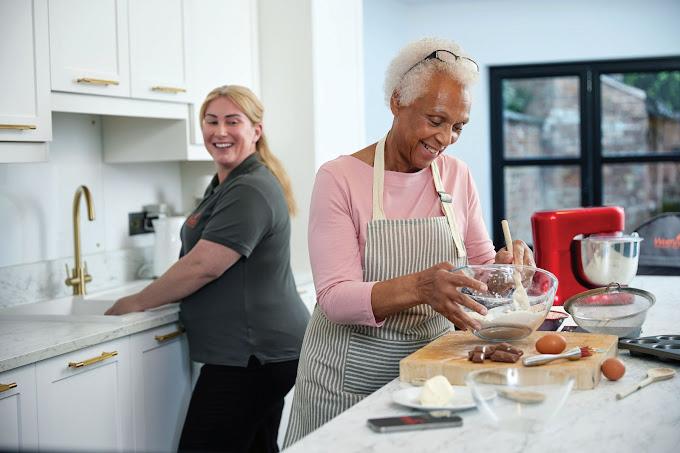





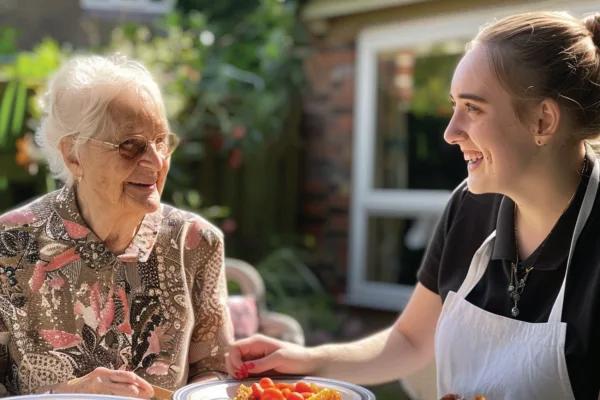




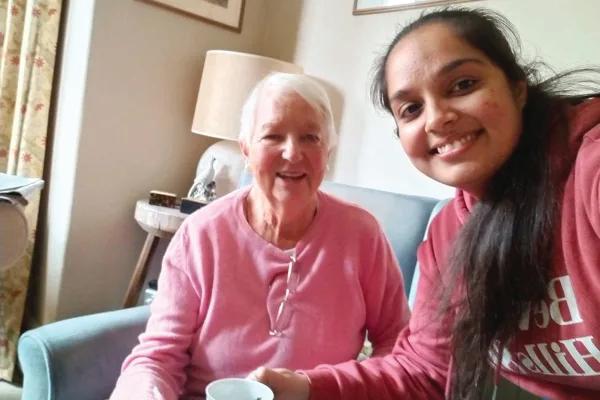
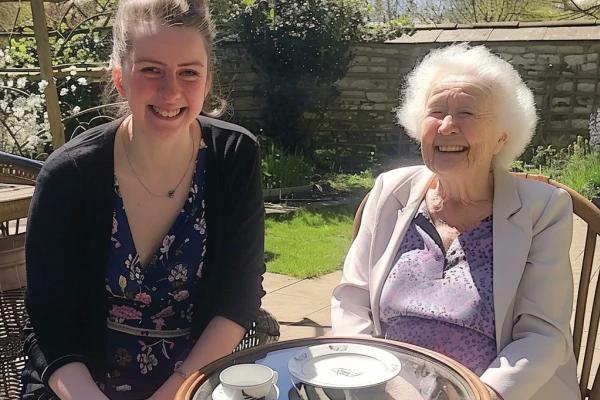
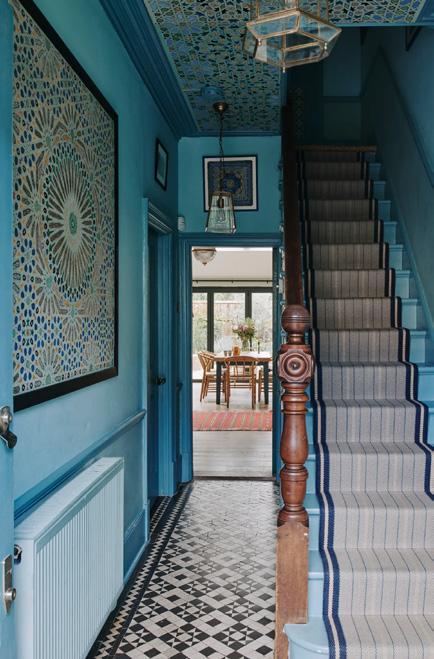
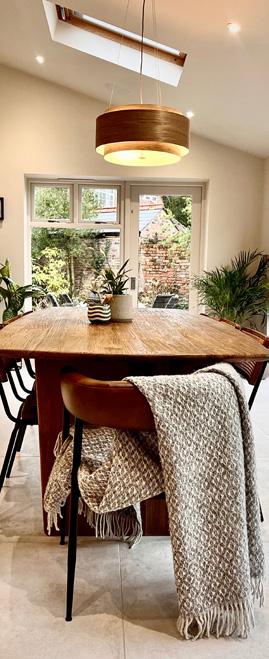


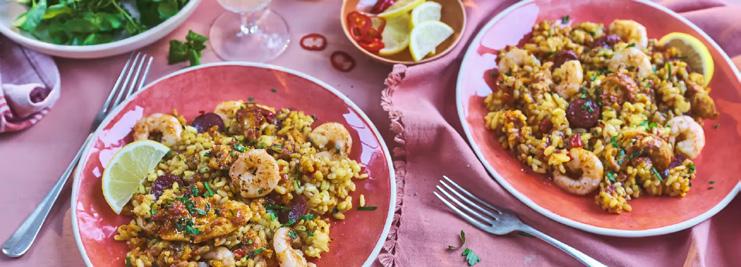

•You





















•You
Welcome to a combined New Year edition of Cheshire’s Golden Triangle and Cheshire South Local magazines, and to our readers, contributors and advertisers we wish you all a very merry, peaceful and prosperous 2025!
In this special edition we have the prestigious Pownall Hall School ‘shining brightly’ and inviting you to their Open Week from the 13th to the 17th of January. We also have our very own Launch Party to which you are all invited on Friday 10th January from 5.30pm at the Swan Inn in Wilmslow where there will be prosecco, pizza and networking with local business owners.
In this issue I interview Charlie Bigham with his newly released cookbook, and local business coach Maria Bryceland; while entrepreneur Kristian Sparrow talks about the art of property investing, and Bee Innes explains how to beat ‘Blue Monday’ through supporting our immune health. We go on our travels, firstly to visit the most exciting UK cities for a New Year’s eve extravaganza, then onto worldwide exploration and ‘The Rise of Expedition Cruising’. Then it’s the Tytherington Club and a spectacular cruise exhibition in early February.
We have several local new businesses and tradespeople showcasing their products and services alongside regular names and marketing companies also showing that collaboration is key to local successful business relationships because as we all know - keeping it LOCAL is truly best for our communities, and on that note, from all the team at LOCAL AREA magazines and CHESHIRE LOCAL, when you get a peaceful minute to yourself between Christmas and the New Year, put your feet up, enjoy a good read, and have a very Happy New Year.

Local Area Ltd has been publishing magazines since 2021, and is still an independent, family run business. Every issue we publish reflects our passion for the areas we serve, and with deep local roots, we’re dedicated to nurturing the unique character of our communities. I hope you enjoy our latest issue!
Jacqui Founder and Editor
To contribute, feature, or advertise, contact: cheshire@localareamagazines.co.uk or please call 07306 146142
@localareamagazines
Cheshire’s Golden Triangle Local Magazine is published by Local Area Ltd, a company registered in England & Wales number 13415030. Registered office: Markham House, 20 Broad Street, Wokingham, RG40 1AH.
Cheshire’s Golgen Triangle Local Magazine, © 2024, Local Area Ltd. Reprinting any part appearing in this magazine is strictly forbidden except by permission of the publisher.
All copyright of images/content remains that of its contributors. Every effort has been made to gain permission to publish copyright material. However, where efforts have been exhausted, we have published based on ‘Fair Use’ to comment factual based material whereby its use is not central or plays a significant part in the entire publication but to act as an aid for historical and educational purposes only. This publication is offered as a limited print run. The publisher, Local Area Magazines, makes every effort to ensure that the magazine’s contents are correct. However, it cannot take responsibility for any effects from errors or omissions. Local Area Ltd accepts all advertisements in good faith but is unable to accept any responsibility or liability for any of the services or products provided by advertisers and encourages consumers to make checks before hiring/buying services, such as a vetted service provided by Trading Standards’ ‘Buy with Confidence’ scheme.













by Jacqui Priestley
Creative hallway ideas that turn this often overlooked area into a welcoming space that will make an appealing first impression. It is easy to forget that an entrance hall is a room, it often receives corridor status, but it is, in fact, an important space.
As the place for arrivals and departures, it sets the tone for the rest of the house, so it needs to be welcoming. For this reason, pay as much attention to the stuff in a hallway as you would in any other room, and don’t use it as a dumping ground for furniture or art that has no home elsewhere.
Just because you’re moving through a space regularly to get to another room where you might spend longer, that doesn’t make it less important – if anything, it makes it more important. The hallway is nearly always the part of a house that you and your guests will encounter first, so make sure it leaves an impression, perhaps by hanging a statement piece of art in it or by introducing an unusual colour.

The interior designer Anna Haines has created a deeply sophisticated and serene home of this Grade II-listed former rectory, using a predominantly pale palette of natural hues, and by layering antique textiles, her choices have brought harmonious charm to its interiors. In the hall, Howe London’s ‘Irish Slim’ table and a Georgian mahogany chair from The French House stand on the Victorian floor tiles.

Natasha Mann →
Behind the door of an unassuming Edwardian house in Manchester, artist Natasha Mann has created a richly patterned world of her own design. I love the bold sky blue colour which greets you as you walk in, and the hand-painted Moroccan frieze on the ceiling draws the eye upwards.


The arresting hallway of this house in Cheshire designed by Rita Konig creates a moment of serious architectural drama, with its double-height plateglass windows, contemporary staircase and floor in black sandstone tiles from Lapicida, which contrast with walls in Edward Bulmer’s ‘Trumpington’.
Nicola Harding
Nicola Harding’s bold use of colour sets the scene for a vibrant and characterful house in Berkshire. The walls are painted in ‘Chelsea Green II’ by Paint & Paper Library, with a dash of blue provided by the vintage love seat upholstered in corduroy from Brisbane Moss (also used for the door curtain), and the custom Rosi de Ruig lampshade that partners the table lamp. In order to make the space feel more dynamic and less like a typical country house, Nicola has used an eye-catching mix of mid-century and Art Deco furniture.

This house in Oxford has been carefully revitalised by Charlotte Boundy. The hallway is painted in Edward Bulmer Natural Paint’s ‘Aerial Tint’; a ‘Convex Globe’ lantern from Jamb hangs overhead.

Treating the hallway as its own room enhances its functionality and aesthetics, creating a cohesive flow within the home. It sets the tone for the spaces it connects, maximizes often-overlooked storage or design opportunities, and ensures it feels intentional, rather than merely transitional or neglected.










by Jacqui Priestley
Discover inspiring success stories in our series spotlighting local business owners. Explore their journeys, challenges, and advice as they share insights into building thriving enterprises within our community. This week Jacqui Priestley caught up with Kristian Sparrow of Ideal Property Group, and this is what he had to say.
Kris, tell me a bit about Ideal Property Group, as in when did you set it up and what does it entail?
I’d set up a number of business’ to cope with different niches in the market. Whether it be HMO lettings, Serviced Accommodation and then onwardly developing and maintaining both. IPG is an umbrella brand name under which the 4 companies sit.
What is the geographical area of focus?
Traditionally South Manchester and Cheshire East, although I expect our latest venture into developing care facilities will take us national.
In these days of financial uncertainty, do property investments continue to outperform other investment opportunities?

Yes, in my view, they absolutely do. The perception is that the barriers to entry are high, which they can be if you are working alone. What’s more the red tape can be stifling
and the complexity of some of the taxation can put people off. BUT if you’re targeted, you know what you are doing, and how to navigate these problems it will outperform any other investment.
Have the recent tax changes had a good or adverse effect on the property investment arena?
Again good and bad. Bad for the layman for certain BUT if you know which properties still have tax relief(s), you structure your purchase vehicle correctly and you can add value in ways that don’t completely break the bank there will always be lots of ways to make great returns.
When did you realise you wanted to become an entrepreneur?
I don’t think it was ever a conscious choice to be honest. My old man always had his own business when I was growing up. Saying that I was 12 when my dad went bankrupt. We ended up working market stalls together and that’s where I learnt how to sell.
However, being an entrepreneur is much more than being a good sales person. It’s about seeing an idea born in your mind play out into a million pound turn over business. It’s creativity, it’s resilience, It’s the
4am courage when everything is falling apart and you know the only person that can rescue you is you. Furthermore, it’s as exhilarating as it is terrifying but I wouldn’t have it any other way.
I have different ambitions for each of my business’ really. But the overall is to streamline, have hyperefficient systems and bring in partners not employees to come on this journey with me.
Becoming an equity millionaire is a nice milestone but I recognise I had to break myself to get there in circa three years.
I love working with JV partners on development projects as I’m confident I can help people accelerate their property ambitions. I really enjoy sharing my knowledge and experience on the speaking circuit of various property networking events.


What advice would you give someone starting up a business from scratch today?
I think setup with the exit in mind, think about the long term goal. At 25, I set up a rent to rent business as it gave fast penetration into the market. However, it doesn’t fit into the buying criteria of a countrywide or other larger agent.
Though, if I’d built up 500 single lets over a 10year period, in a nice vanilla system I’d have been bought out for £ millions. As I have become more experienced I realise how important it is to bring the right people with you on the journey, cut them in and properly incentivise those around you.
If you’re diversifying and starting new ventures…yet you continue to run “top down” structures you’ll end up stressed and lonely. I’ve learnt that one the hard way but what’s important is we recognise that and are effecting change.

Reliable Homecare?
A reliable electrician?
Extra security?
Looking to book your holiday?
Financial advice?
Help to sell your house?
Mortgage advice?
Looking for a reputable cleaner?
Graphic design? Architect?

Grass and hedge cutter? A decorator?
Excellent Cleaner?
Leaflet distribution services? A Landscaper?
Stationery & Gifts?
I.T support in the workplace?
Blinds & Shutters?
Looking for CCTV?
Leaf Organics CBD oil?
Iconic Furniture?





by Jane Horsburgh of Ava Rose Interiors

With the sparkle of Christmas now behind us for another year, the first quarter can feel a little dark and dull. The days are still short and the weather is harsh. During these months, we’ll spend more time indoors and our homes need to work harder for us. This disconnect with nature can play with our mental health. So what can we do to help? There is no better time for Biophilic Design to take centre stage.
Biophilic Design is a building design philosophy that connects people to nature, using natural elements like light, plants, organic materials, water and organic scents that fill each of our senses & help foster a sense of refuge and security. Bringing Biophilic Design into your home in its existing form doesn’t need to be a costly or disruptive exercise. Here are some tips to help get you started on your Biophilic design journey:
Plants improve air quality, reduce stress can help induce sleep, whilst creating a calming environment. Use indoor plants like ferns, succulents, and hanging plants to bring nature indoors. Vertical gardens or plant walls are a great way to add greenery without taking up floor space.
Furthermore, adding natural materials evoke the essence of nature, enhancing tactile and visual comfort. They also tend to be free from toxins and can help improve indoor air quality.
If unsure of sustainable suppliers, website’s such as Moral Fibres will give insight into ethical companies.

Views of nature stimulate a larger portion of the visual cortex than non nature scenes, triggering the pleasure receptors in our brains, reducing stress and improving focus. Direct views onto gardens or green spaces whilst you’re working or relaxing are ideal. Growing herbs or wild flowers in window boxes may be a viable alternative. There are other methods that can be built in or simulated if natural isn’t an option, such as living walls, hanging planters and wall terrariums. In addition, large landscape prints or murals of views that are meaningful to you are a great way to evoke those calm feelings.

Natural light boosts mood and helps regulate circadian rhythms, enhancing health and well-being within your home. If embarking on an extension or remodel of your home, ensure adequate time is spent on how the new space will flow, impacting window placement, the direction the window is facing and how furniture can be organised so when in the space, you can enjoy the natural light to it’s fullest.
As a quick fix, ensure any heavy window dressings (curtains / blinds) are pulled back away from the window to ensure maximum daylight is filtering through. Position furniture to allow natural light to flow through spaces, moving large, heavy pieces away from windows where possible.
If none of these are viable options, you could invest in a light therapy task lamp or bedside alarm. These lamps are ideal if natural daylight cannot be increased.
Engaging multiple senses, including smell and hearing will enhance the connection to nature and promote well-being. Include elements that engage more than just sight, such as the scent of natural oils using candles, diffusers and natural odours from plants, herbs and flowers. Scent can evoke such strong memories so choose odours that appeal to you. Peppermint has a positive effect on focus and lavender can aid relaxation as an example. Sounds are also a great way to increase our connect with nature. Water features can bring nature sounds into the home or there are devices that emit birdsong.


The above guide provides some food for thought on why our connection with nature is so important and how the disconnect can negatively impact our mental health. Being more biophilic also doesn’t need big budgets. There are simple solutions to be had that’ll help our homes become our sanctuaries, providing that safe refuge to see us through till the Spring!

▪ Specialist
▪
▪ O ces
▪
▪ Free 30-minute consultation.













by Bryony Hallworth, Features Writer
When The Cheshire Mercantile opened its doors in March 2024, my first exchange with the owner, Andy, was something along the lines of ‘if I promise to spend all of my money on cheese and beer, please will you open a bar?’ I can wholeheartedly say I’ve kept up my side of the bargain and should probably have a stern word with myself about my cheese to bank balance ratio.
This has even more so become the case since The Cheshire Mercantile have installed 4 keg lines and a few bar stools in recent months, which has given me both more reason to go, and fewer reasons to leave.
Generally, I find it difficult to drag myself away from the window seat, where ‘a quick one’ can very easily turn into a few hours and pints later and an emergency cheeseboard and/or scotch egg.

However, on my most recent visit, after a pint of The Cheshire Mercantile’s collaboration brew with Poynton’s brewery, Neighbourhood Brew Co., I was well ready to take myself home with an armful of ingredients for dinner, feeling thoroughly inspired by The Cheshire Mercantile’s piccolo ciao to Italy.
I was glad for the excuse to buy a slab of Delice De Bourgogne, in particular. Generally I don’t trust myself to buy this triple cream cheese from the Burgundy region without a very specific plan for it, at risk of just eating it like an apple (apparently it is considered uncouth to do this with soft cheese).

On a busy weeknight, there’s something comforting about pulling together a meal that feels special without being complicated. I wasn’t after cooking something fancy, but I did want to be able to taste that I’d used carefully selected products. Being honest, there is nothing special about this recipe, or how it is put together, other than the fantastically
flavourful ingredients that have been switched in instead of the usual supermarket staples. That being said, if I wanted bogstandard pasta and creamy tomato sauce I’d have gone to the supermarket and bought bog-standard tinned tomatoes and bog-standard cream cheese.


The dish I put together is simple to make, but the flavours are anything but ordinary. The tinned cherry tomatoes bring a vibrant sweetness, while the Delice de Bourgogne cheese adds a luxurious creaminess that takes the sauce to another level, the sopressata brings a little heat, the toasted pine nuts add crunch.
The drizzle of thyme-infused honey lends a sweet, herby warmth that ties it all together. What makes it even better is knowing where these ingredients come from – an independent, artisan business, with a face and a heart, that has quickly created a community around it and is supported by people who want to know that the products they buy have been deliberately, carefully and locally selected.



The Cheshire Mercantile started as somewhere that I was excited about for its vast canned and bottled beer selection and has evolved into my go-to place for beer, cheese, socialising, coffee, crisps, chocolate, and now Italian staples. Oh, and Moonshine. Let’s not talk about the Moonshine.
Ingredients
(Serves 4)
1 large shallot
3 garlic cloves
Handful of fresh thyme
Handful of fresh basil
1 tsp of dried Italian seasoning
4 tbs pine nuts
From The Cheshire Mercantile:
2 tins of Pomodorini Datterini Non Pelati Interi tomatoes (I used the non pelati interi ones, which are basically cherry tomatoes packed in tomato juice)
200g of Delice De Bourgogne
1 bag of Northern Pasta Co Radiatori
1 Cotswald Curer Sopressata sausage
4 tbs of Wilmslow Honey

Method
Step 1
Put thyme and honey in a small pan, heat on your lowest setting to infuse the thyme flavours into the honey. Slice the Sopressata into cubes and pan fry. Once crispy, set to one side, reserving the oil that is released from the sausage.
Step 2
Dice 1 large shallot and 3 cloves of garlic and pan fry in the oil from the sausage until soft (you may need to add some extra oil at this point). Get your kettle boiling while you’re doing this. Once softened, add two cans of tomatoes, a teaspoon of Italian seasoning, some fresh thyme, basil, salt and pepper to taste, and cook on a medium heat for 10 minutes.
Step 4
Turn sauce down to a low simmer and add 200g of Delice De Bourgogne and stir while the cheese melts. Use a stick blender for a smooth sauce, or a potato masher for chunky.
Step 5
Boil the Northern Pasta Co pasta for 5 minutes. When cooked, drain and stir through the pasta sauce.
Step 6
In a small frying pan, toast the pine nuts – keep an eye on them and stir frequently to avoid burning – adding your Soprasseta that you fried earlier.
Serve pasta in a bowl, topped with the Soprasseta and pine nuts and drizzle the thyme infused honey over the top, garnish with a few basil leaves.












This cocktail is a spin on the famous Bellini cocktail. It’s refreshing, elegant and bright which makes it a perfect cocktail to serve with appetizers and snacks at the beginning of the party or, just like the classic Bellini, it’s one of the top choice for brunches.
Ingredients
2 large pomegranates
1 carton pomegranate juice
1 bottle Prosecco wine
Fresh rosemary sprigs for garnish (optional but adds a festive look)

Cheshirepartyplanner.co.uk
07765 281237
Method
Step 1
When ready to serve fill 1/3 of a flute glass with pomegranate juice. Carefully add well chilled Prosecco without letting it overflow.
Step 2
Stir with a bar (tall) spoon to combine pomegranate juice with Prosecco.
Step 3
Top up with more Prosecco, garnishing with a fresh sprig of rosemary and a few pomegranate seeds.

By Simon Bollington, Travel Expert
As a Travel Counsellor I am often asked ‘which is ‘The Best City in the UK to Celebrate New Year’ and here are my thoughts....
New Year’s Eve is undoubtedly one of the most exciting nights of the year, offering the perfect opportunity to welcome a fresh start with our loved ones, spectacular events, and memorable celebrations. In the UK, cities compete to provide unforgettable New Year’s Eve experiences, but some stand out more than others.
Whether you’re seeking dazzling fireworks, lively street parties, or unique cultural traditions, there’s a city for everyone. Let’s explore the top UK cities to celebrate New Year and reveal the ultimate destination.
London is often the first city that comes to mind when considering New Year’s Eve. The capital’s famous fireworks display along the River Thames is broadcast worldwide, attracting tens of thousands of spectators to iconic landmarks like the London Eye and Big Ben. Ticketed viewing areas ensure that visitors can

enjoy the breathtaking pyrotechnics in a secure and organised manner. Beyond the fireworks, London offers a variety of events to suit all tastes.

Whether it’s dancing the night away at one of the city’s renowned nightclubs or attending elegant dinner cruises along the Thames, London’s nightlife is unparalleled. Venues like Sky Garden and The Shard also provide exclusive experiences, offering panoramic views of the city’s skyline. However, it’s important to note that London can be crowded and pricey during New Year’s Eve. Accommodation and event tickets should be booked well in advance to avoid disappointment.
For those seeking a truly unique and culturally rich New Year’s celebration, Edinburgh’s Hogmanay festival is hard to beat. Hogmanay, the Scottish term for New Year’s Eve, is a three-day extravaganza featuring street parties, concerts, torchlight processions, and more. The celebrations are steeped in tradition and offer an atmosphere unlike any other.

Highlights include the massive street party on Princes Street, with live music and DJs keeping revellers entertained until midnight. When the clock strikes twelve, a spectacular fireworks display lights up the sky above Edinburgh Castle. Additionally, the New Year’s Day Loony Dook, where brave participants take a dip in the freezing Firth of Forth, adds a quirky twist to the festivities.
Hogmanay attracts visitors from around the globe, so it’s advisable to plan your trip early. The city’s charm and the warmth of its people make it a top contender for the best New Year’s Eve destination.



Manchester is a fantastic choice for those who enjoy a lively atmosphere without the intense crowds of London. Known for its thriving music scene and friendly locals, Manchester offers an array of events to ring in the New Year. For something unique, head to the Warehouse Project, a legendary clubbing venue that attracts top DJs from around the world. For a more family-friendly experience, Manchester also organises smaller events with activities for children, ensuring everyone can join in the celebrations.
Cardiff provides both a charming and inclusive atmosphere for New Year’s Eve. The city’s Winter Wonderland is a popular attraction, featuring ice skating, fairground rides, and festive food stalls. Cardiff’s Calennig celebrations often include free events such as live music and fireworks, making it an affordable yet festive option. The city’s compact size means it’s easy to navigate, allowing visitors to explore multiple venues without hassle.


Belfast combines a lively nightlife scene with stunning surroundings, creating a unique backdrop for celebrations. Cathedral Quarter is the hub of activity, with its historic pubs and trendy bars hosting live music and special events. The Titanic Belfast attraction organises glamorous NYE parties, providing a hint of elegance and history to the night.

If you’re looking for a world-class spectacle with iconic landmarks, London is the obvious choice. For a true Scottish experience, Edinburgh’s Hogmanay is a must. Manchester offers a vibrant yet manageable party scene, while Cardiff’s affordability and warm atmosphere make it a great option for families. Belfast provides a mix of lively nightlife and historic charm. Edinburgh’s Hogmanay definitely stands out as the most memorable New Year’s celebration in the UK. Its blend of tradition, spectacular events, and warm hospitality makes it a bucket-list experience for anyone looking to welcome the New Year in style.
Dreaming of your next adventure?
Let Simon, your expert Travel Counsellor, make it a reality! From unforgettable escapes to stress-free planning, Simon is here to guide you every step of the way.
Get in touch today to start crafting your perfect getaway!
























by Francesca Wharton, Luxury Travel Consultant

Imagine standing on Antarctic ice surrounded by penguins, spotting a polar bear in the Arctic wilderness, or marvelling at a giant tortoise in the Galápagos Islands. With expert-led excursions, expedition cruising blends exploration and elegance, redefining what it means to travel in style.
Expedition cruising revolves around exploration. Using smaller ships –typically carrying fewer than 200 guests – these journeys take you where larger ships cannot. Purpose-built to navigate challenging waters and unspoiled, remote regions, these ships combine rugged capability with refined luxury.


They’re equipped with Zodiacs for shore excursions, stabilisers for smooth sailing, and observation decks for unparalleled views. Yet, there’s no compromise on comfort. On board, you’ll find elegant cabins, gourmet dining, and spaces for relaxation, from observation lounges to wellness spas. However, the real heart of the experience lies in the expert-led itineraries. Specialists like marine biologists, geologists, and historians enrich the journey, offering lectures and leading shore excursions that bring each destination to life.
Expedition cruising opens the door to places most people only dream of visiting.
The Arctic
Explore the icy wilderness of Svalbard, Greenland, or Iceland - dramatic landscapes, stunning glaciers, and, if you’re lucky, the elusive polar bear.
Antarctica
A land of surreal beauty with vast icebergs, towering glaciers, and bustling colonies of penguins.
The Galápagos Islands
Home to some of the most unique wildlife on Earth, from giant tortoises to playful sea lions.
Closer to Home
Scotland’s remote islands, Norway’s fjords, and even the wild beauty of the Faroe Islands with wildlife like puffins, seals and whales.
From the tropical splendour of the Seychelles to the culturally rich coastlines of Southeast Asia.
Mornings might begin with a Zodiac excursion to a secluded beach or kayaking through crystal waters surrounded by glaciers. You could find yourself snorkelling alongside sea lions in the Galápagos or watching walruses resting on an ice floe in the Arctic. Back on the ship, a gourmet lunch awaits, often with regional delicacies. Afternoons might include a lecture by an onboard expert, a cooking demonstration, or simply enjoying breathtaking views from the sun deck. Evenings tend to be relaxed,
with fine dining, sipping a glass of wine on deck or swapping stories with fellow passengers in the lounge. Sometimes spontaneous wildlife sightings –perhaps a humpback whale breaching near the ship.

Expedition cruising is growing rapidly, and it’s not hard to see why. People are seeking more meaningful travel experiences. Unlike traditional luxury holidays, these journeys are deeply immersive, offering rare opportunities to connect with nature, history, and culture in an intimate setting.
You’ll leave, not just with stunning photographs, but also a deeper understanding of the places you’ve visited. For the environmentally conscious, many expedition cruise lines are taking steps to minimise their environmental impact, from using hybridpowered ships to banning single-use plastics.
Expedition cruising is ideal for those who crave adventure but appreciate luxury. It’s perfect for couples, solo travellers, and families with older children who share a passion for adventure.
If you dream of seeing colonies of blue-footed boobies, sailing by a pod of beluga whales or witnessing fire dances by the indigenous tribes of Papua New Guinea, expedition cruising is the perfect escape. It’s more than a holiday, it’s a journey of discovery that will stay with you for a lifetime. Isn’t it time to start planning your next great adventure?







by Lesley Black
As we step into 2025, comfort continues to dominate the world of interior design. With the home increasingly becoming a sanctuary, people are re-imagining their spaces to create environments that prioritise relaxation and well-being. This trend reflects a shift towards a slower, more intentional lifestyle, where aesthetics harmonise with practicality.
The concept of comfort starts with furniture. Plush sofas with deep seats, oversized armchairs, and ergonomic designs are at the forefront of 2025’s interior trends. Natural fabrics like cotton, linen, and wool are favoured for their tactile qualities and breathability. Modular seating systems, which allow flexibility for changing needs, are also gaining traction. The emphasis is on creating versatile living areas that cater to work, play, and rest without compromising on comfort.


Colour palettes in 2025 are inspired by nature, with earthy tones such as terracotta, sage green, and warm browns taking centre stage. These hues evoke a sense of calm and connection to the natural world. Texture plays a critical role too, with soft furnishings like knitted throws, bouclé cushions, and shaggy rugs adding layers of cosiness. Even hard surfaces like wood, stone, and ceramics are being chosen for their organic, unpolished finishes, which lend warmth to interiors.


Smart home technology seamlessly integrates with the comfort trend, offering solutions that enhance ease and relaxation. Adjustable lighting systems that mimic natural daylight, temperature-controlled floors, and voice-activated devices create an environment tailored to individual preferences. Far from feeling intrusive, these innovations are designed to blend invisibly into home décor.

Finally, comfort is deeply personal. In 2025, people are increasingly curating their spaces with meaningful items, from family heirlooms to handmade crafts. These elements tell a story, turning houses into homes where residents feel truly at ease.
Interior décor in 2025 goes beyond the physical aspects of comfort, embracing the concept of wellness. Biophilic design, which incorporates natural elements such as indoor plants, water features, and abundant natural light remains popular. These features are proven to reduce stress and improve mental health. Thoughtful layouts that ensure good airflow, quiet corners for relaxation, and mindful lighting designs further enhance the home’s role as a rejuvenating retreat.

In essence, the interior décor of 2025 champions comfort as the cornerstone of design, blending style, function, and emotional well-being into spaces that feel as good as they look.



“Smarter Home 4U were excellent from beginning to end. The job was to improve our lounge; it was a messy, dusty business but they covered everywhere with protective sheeting.
They were clean and tidy, friendly, and hard working. I was up against a deadline and they helped ensure the date was achieved. They kept me informed at every stage, and went the ‘extra mile’ to do a good job. I have no hesitation in recommending them.”
Smarter Home 4U have transformed countless properties across Greater Manchester and Cheshire. From those odd jobs around the house to fullscale extensions and restorations, we draw on over 30 years’ experience to deliver the highest standard of workmanship every time.
A family run business since 2013, we carry out all types of home improvements, inside and out, whether you’re a homeowner wanting to give your property a makeover, or landlord seeking a quick, cost-effective fix for a tenant.
No task is too big or small for Smarter Home 4U. Whether you’re putting up shelves or planning major refurbishment works, we combine our hands-on knowledge with an honest, hard-working approach to deliver the best solutions for our clients.









by Bee Innes, Registered Naturopathic Nutritionist
As we dive into January, with Blue Monday on the 20th thought of as the saddest day of the year, energy and mood tend to be low and the risk of bugs increases. Whether you’re an individual looking to stay healthy or a manager hoping to reduce sickness-related absences, supporting natural immunity can make all the difference.
At 24, following what I thought was flu, I developed Myalgic Encephalomyelitis and Fibromyalgia, leaving me in bed for almost a decade, reliant on caregivers, and unable to work. I ignored signs of a compromised immune system, such as dry skin, allergies, and digestive issues, for years beforehand.
Had I known how to spot them and support my immune health through food, lifestyle changes, supplements, and detoxification, I might have avoided this. Mould exposure in my rented accommodation also played a role, as mycotoxins from mould can severely impact the immune system.
Now, as a health practitioner specializing in gut health, fatigue, women’s health & employee wellbeing, I use my personal experience to guide others to take control of their own health naturally. With that in mind, I’d like to share my top three tips for supporting immune health.


Sugar is one of the biggest culprits when it comes to weakening your immune system. Consuming just six teaspoons of sugar (about one chocolate bar) can reduce your white blood cells’ ability to fight off harmful microbes by 25% for hours afterwards. Even “sugar-free” options can be problematic due to hidden sugars and artificial sweeteners.
Refined carbohydrates, like white rice, bread, pasta and pastries, can also convert rapidly into sugar in the body, leading to energy slumps and cravings. Start the day with protein before 10 a.m. This helps stabilize blood sugar and prevent energy slumps. Try homemade granola made with nuts, coconut oil, cinnamon, and a pinch of Himalayan salt. Pair it with coconut yogurt and fresh berries for a delicious, sugar-free breakfast.
Did you know 80% of your immune system resides in your gut? This makes gut health essential for supporting immunity. Probiotics, found in foods like sauerkraut and kimchi, can help replenish beneficial gut bacteria. Choose raw or unpasteurized versions, as pasteurisation destroys the live bacteria.
Prebiotics, the fibre-rich foods that feed these beneficial bacteria, are also crucial. Excellent sources include onions, garlic, Jerusalem artichokes, green tea, and even dark chocolate. The higher the percentage with dark chocolate, the lower the sugar.
Additionally, aim to eat a variety of colourful vegetables, targeting nine servings a day. If you struggle with bloating when doing so, a nutritionist can help you find the right approach to support your gut health.

Vitamin D is crucial for immune health, especially from late September to March when the sun is not high enough in the sky to obtain vitamin D through skin. Low levels can negatively affect immune function and contribute to conditions like COVID-19. I like to see optimal levels of around 125 nmol/L.
While foods like wild salmon, organic liver, and eggs provide some vitamin D, it’s difficult to get enough from food alone, especially if following a vegan diet. I like to see exactly where someone’s levels are so I can assess the exact level of supplementation needed to get someone to optimal.
By reducing sugar intake, optimizing your vitamin D levels, and supporting your gut health, you can enhance your overall well-being and reduce your risk of sickness. Take control of your immune system today and enjoy a happy, healthy new year!

“My migraine is gone!”
“My skin has cleared up beautifully”
“People are asking “Have I had work done!”
“I feel better at 52 than I have done for years”
“Heavy bloating, constipation & brainfog have gone!”
“Bee helped me with anxiety & hormonal imbalances”
“Any asthmatic symptoms I once had have completely vanished”
“Almost pain free & energised & being able to sleep is miraculous!”
by Maria Bryceland, Leadership Coach

As we step into the New Year, it’s a perfect time to reflect and reset. I prefer calling it ‘work-life harmony’ rather than the traditional ‘work-life balance.’ Why? Because balance often feels like a juggling act, where dropping one ball feels like failure. Harmony, on the other hand, is about finding the right rhythm—a mix that feels fulfilling and is adaptable to life’s everchanging demands.
The New Year often brings feelings of hope, determination, and maybe even guilt about what didn’t go as planned last year. Maybe you feel like work took over family time, or personal goals were left behind while managing day-to-day life. But here’s the thing—it’s not about guilt or perfection. Harmony is not a destination; it’s an ongoing process, a continuous evolution.
The key is being present and intentional. Know when you’re at your best and what you need to stay in that zone. As you set your goals and intentions for the year ahead, here are some areas to focus on:
Just like the aeroplane rule—‘put your oxygen mask on first’—your health is foundational. Whether it’s a new fitness routine, healthier meals, or simply taking time to recharge, prioritising your wellbeing is not selfish, it’s crucial and allows you to show up fully for others.


Are you getting enough sleep to thrive? Rest isn’t just about avoiding burnout—it’s essential for clarity, energy, and productivity. If sleep is an area you’ve neglected, consider how you can prioritise it this year. A top tip is to try having no devices in the bedroom (or whilst winding down before bed!).
Take a moment to acknowledge how you’re feeling as you start the year. Whether it’s guilt over what wasn’t done, joy about a fresh start, or even anxiety about what’s ahead, understanding your emotions is a powerful step toward clarity. Use these feelings as a guide to set priorities rather than as a reason to criticise yourself.


What’s your purpose? Why do you do what you do? When you’re clear on your ‘why,’ it becomes easier to filter out distractions and focus on what truly fulfils you. Use the New Year to align your work, family, and personal life with that purpose.
Take action on what matters most. Could you schedule that long-overdue holiday, say no to obligations that no longer serve you, or yes to reconnecting with a friend? Perhaps this is the year to delegate more, reassess your career direction, or invest time in a new passion. Small, consistent steps can lead to big shifts. Remember, work-life harmony isn’t about rigid schedules or achieving perfection—it’s about being flexible, adapting as life happens, and being kind to yourself.
As you step into the New Year, take a step back and ask: What small changes can you make to create more harmony in your life? Whether it’s prioritising rest, refining your purpose, or simply being kinder to yourself when things don’t go as planned, every little effort adds up.
This year, don’t just succeed—thrive!
Experience personalised, prompt care with our private GP services at The Nantwich Clinic. No waits, longer appointments, and a GP who truly knows you.
If you’re frustrated with long waits and rushed appointments, never seeing the same doctor twice or feeling like you’re just another name on a list, our private GP services offer a refreshing alternative – a return to a more traditional, personal level of service, built on trust, understanding and continuity of care.
With flexible appointment options you can choose when best fits your schedule. Our GPs are here to give you the time and attention you deserve, providing you with peace of mind and a truly personalised approach to your health.
Nantwich Clinic’s Private GP - Dr Dave Roberts has this advice on how to stay warm, stay safe, and take care of yourself!
As a GP, I often see winter taking a toll on physical and mental health. The colder months are a time to prioritize self-care and well-being. Here are my top tips to stay healthy and strong:
Eat a balanced diet rich in fruits, vegetables, and whole grains to provide your body with essential nutrients. Vitamin D and C are key — consider supplements if needed.
It’s tempting to hibernate, but regular movement is vital. Even light activities like walking, stretching, or home workouts can improve mood and circulation.
Protect yourself against seasonal flu, COVID-19, and other winter illnesses by staying up to date on vaccinations. Prevention is always better than cure.
The darker days can impact our mood. Make time for hobbies, social connections, and self-reflection. Don’t hesitate to reach out if you’re feeling low.
Drink plenty of water, limit alcohol intake, and prioritize quality sleep to keep your immune system functioning at its best.
Don’t ignore lingering symptoms or minor health concerns. Seeing your GP early can prevent small issues from escalating.
Remember, winter is tough on us all, but with proactive care and small, consistent steps, we can stay resilient and healthy. Let’s look forward to spring with strong bodies and brighter minds.








by Kathleen Johnson, Dietician
You hear the phrase “Mediterranean diet” a lot when doctors talk about hearthealthy eating. And with good reason: Its hallmarks — healthy fats and plant foods — have been shown to be very beneficial to heart health. But there’s a wide world of other international choices out there that share these nutrition principles.
Mixing up the types of foods you eat can make your diet more interesting and help you stick longer and more easily to these life-changing principles, says registered dietitian Kathleen Johnson.
Try some of the following tasty, good-for-you choices that favourite ethnic cuisines have to offer.

Mexican
A staple of Mexican cooking is the tortilla. Start by choosing organic corn tortillas over wheat for more minerals and fibre. It’s also a smart choice for many people who are looking to lower their fat and sodium intake, Johnson says.
Select fish, chicken or vegetable dishes. Black beans are a great source of protein — pick them over refried beans. For a topper, try a little guacamole. Avocado is a heart-healthy fat, and cilantro (a common spice in guacamole and Mexican dishes) is surprisingly full of antioxidants.



The abundance of vegetarian options makes it easy for heart-conscious diners to go out for Indian food. The warming spices they feature, such as turmeric and garam masala, are also anti-inflammatory, which is great for the heart.
lentil dal — lentils are a good source of protein
chickpea vindaloo
chana masala (made of chickpeas) and bhindi (okra)
rajma — it features kidney beans in a thick sauce


Fish dishes — hallmarks of the Japanese diet — are an excellent source of important omega-3 fatty acids for your heart. But be aware that Japanese foods can have a lot of sauce. “It’s best to ask for sauce on the side if you can’’. Also choose brown rice over white for more heart-healthy fibre.


What these cuisines have in common is a lot of vegetable tagines, a type of stew named after the earthenware pot in which it’s cooked. “Ethiopian restaurants are a great place to take kids because they get to eat with their hands,” Johnson notes. Rather than utensils, the food is eaten with a flatbread made of teff flour, which is thought to help with blood-sugar management.


Charlie Bigham, founder of the brand of ready to cook meals found in wooden trays in supermarkets across the country, has released his cookbook ‘Supper with Charlie Bigham’. Packed with over 100 easy-going, delicious recipes, the book is all about the joy of gathering loved ones around the table. It celebrates fresh, quality ingredients and turning them into fuss-free meals anyone can whip up - perfect for casual cooks as well as discerning foodies.
Tell us about the cookbook - what’s in it and why have you decided to write it now?
I’ve included all my favourite recipes from home that have been refined over the years and have got the thumbs up from family and friends, such as a quick baba ganoush with toasted pitta and rabbit ragù pappardelle. There are also some Charlie Bigham’s classics that customers will recognise such as fish pie, chicken tikka and lasagne.
Over the years a lot of customers have suggested I write a cookbook – it’s finally happened and has turned out to be a lot of fun. Everything is easy to cook, full of flavour and, in keeping with how I like to cook, can be made without any fuss while having a good chat (and maybe a drink) with whoever happens to be with you in the kitchen. I’m hoping that the book will inspire people to try cooking a

few things they may not have cooked before — and have a great time doing it!
What did you learn and gain from the experience of travelling around the World?
I have been very fortunate to do lots of travelling and I learnt a lot about food. What I feel about food in the UK is that we have such diversity from everywhere else in the World because we are so open to ideas from other countries and to incorporating them into our own recipes, so there isn’t just one style of British cooking, and that is replicated in our extensive range of foods.
Did you have an ambition to become a famous chef, and do you want to be a celebrity chef now?
No, I had no ambition to be a chef, and celebrity chefs had not been invented yet. I describe myself as a cook, rather than a chef. Chefs in restaurants are true professionals to get their different dishes out all at the same time, and hats off to them!
↓ Paella with King Prawns, Chicken, and Chorizo

What gave you the initial idea to start a company selling freshly prepared meals?
Well I needed a job, and I like to work for myself, as I was never very good at working for someone else, and I guess I just thought I would take a ‘punt’. My thinking was that there must be more people like
↓ Beef Madras, in a tomato and coconut sauce

me out there, leading busy lives, and occasionally thinking I love cooking, but could just do with a night off whilst not compromising from eating good quality food. The only real option at that time was the frozen ready meal and I feel life is too short to resort to eating cheap meals from a microwave.
Do you consider your meals to be expensive, and are they therefore targeted at ‘posh’ people?
No, they are amazing value for money, and are enjoyed by all types of people up and down the Country, and we gauge this from the consumer research we do.
For example, in comparison to a Domino’s pizza, we are cheaper, better quality and we really leave them for dust! So, we are not about posh people, we are about everyday food appealing to a broad cross-section of people - and providing brilliant value for money.
What is your all-time favourite from your amazing range of recipes?
I think as a dish that most people like, as do I, our
lasagne is a brilliant dish, and very well executed. Some may think it old-fashioned but it is an amazing lasagne, made with the best of quality ingredients.
↓ Slow-cooked Beef and Pork Lasagna

When you are entertaining at home, what dish do you cook to impress?
I love cooking and I am something of an inventive cook and I like to challenge myself, and I practically never make the same dish twice. I do love middle eastern food, partly because it is so sociable with the sharing aspect, and a nice relaxed way of eating.
To what do you attribute your success, in an industry saturated by similar products?
Well, I don’t believe there are similar products, I think we are quite different and that’s why people buy our products. Other companies look to make their products cheaper, whereas we focus on making our meals better, and that is the difference.
As consumers, I feel we are all becoming more considered food purchasers, as we are now more aware that the food we eat has an impact on our lives, and even our mental health, and also the effect that food production has on the planet, and we are a very considered food producer.
You are now a B Corp certified business, did it take some time and effort to gain that certification?
B Corp registration is still quite new for the UK, and it means that you sign up to do three things; focusing on Profit, People, and Planet. All businesses need to make a profit, of course, and then looking after your people and also looking after the planet.
What is the single best piece of advice anyone has ever given you?
To listen to our consumers, especially if we have done something wrong, and have their feedback. It is gold dust to us when someone tells us where we went wrong because it gives us an opportunity to put it right. Plus, we have a big team now and now it is important to listen to them. They all have their areas of expertise and know those better than I do, so it is important not just to talk, but to listen to them.
If you could sum up what you stand for in one phrase, what would that be?
In business, really I stand for two things. Firstly, we stand for delicious food, and secondly doing business in a better way and because business should be a force for good. So in the making of that delicious food we are always searching for a better way.
We’ve created what we’re calling a Food Production Campus (well, it is rather grand) in a former quarry in Dulcote, near Wells. We make some of our best-selling dishes here including our Fish Pie and Chicken Tikka Masala. Surrounded by the birds and the bees, we’re excited to make food in such a glorious location.
Charlie’s new cookbook, ‘Supper with Charlie Bigham’ is out now.

Oh, baby it’s cold outside, and nothing will warm your heart and soul more than a frothy mug of spiced Mexican hot chocolate. Whether you have the special chocolate tablets on hand, or want to recreate your own, this recipe is sure to provide a consistently luxurious hot chocolate-sipping experience. For a nice jolt, it is delicious with a shot of espresso, or for a different kick, some spiced rum!
Ingredients
Whole Milk
1 Cinnamon Stick
3 Mexican Hot Chocolate Tablets
(These are special tablets of chocolate often mixed with cocoa, sugar, and cinnamon. Popular brands include Abuelita or Ibarra)
1 tsp Vanilla Extract
Pinch of Salt
Pinch of Cayenne or Chilli Powder

Method
Step 1
In a medium saucepan, combine the milk and cinnamon stick. Heat the milk over medium heat until the mixture begins to steam. Add the chocolate drink tablets and whisk until melted and well combined.
Step 2
Remove the pan from heat and discard the cinnamon stick. Add the vanilla, salt, and cayenne, if using. Use a whisk to vigorously mix the hot chocolate until it’s very frothy. Serve hot, with whipped cream.


I see from your business website that you are an ‘Aspirational Culture and Leadership Coach’. What does that mean, and what is it that you do?
I work with leaders and businesses to create environments where both people and profits thrive. Being an ‘Aspirational’ coach means I help individuals and teams think bigger, dig deeper, and align their actions with their vision. By focusing on culture and leadership, I guide businesses to build values-driven workplaces that empower their people and enable long-term success. It’s about unlocking potential and turning aspirations into reality.


You are based in Cheshire, would you say that is your favourite part of the UK?
Cheshire is incredible, I’m especially drawn to the areas like Bollington, where I live, that border the Peak District. I love being able to step out of my back door and immediately be surrounded by nature for walks, runs, or cycling.
It’s the perfect balance close enough to the city for its energy and culture yet surrounded by the calm and beauty of the countryside. It’s where I feel most at home and inspired.
You talk about ‘work life harmony’. Is that the same as work/life balance?
Not exactly. Work/life balance often implies an equal split of time, but harmony is more fluid and personal. It’s about finding the right rhythm for your current priorities and being intentional about what matters most. Harmony allows for flexibility to adapt to life’s changes without guilt, focusing on quality over quantity in both work and personal life.

What challenges do entrepreneurs face in 2025 that were not apparent a few years ago?
The pace of technological change and AI adoption has sky-rocketed, leaving many entrepreneurs racing to adapt while maintaining authenticity in their businesses. This can be a struggle for them.
Hybrid working has reshaped team dynamics, making culture building more complex. Additionally, there’s growing pressure to align businesses with sustainability and societal impact, as customers increasingly prioritize values-driven companies.
do you do to de-stress?
For me, it’s all about getting outdoors and being active. I love riding my bike and getting lost in nature—it clears my mind and recharges my energy. Spending time with loved ones and reading also
helps me stay grounded and centred.
What’s the best advice you’ve been given?
To focus on the journey, not just the destination. Happiness isn’t found in ticking off goals or achieving success—it’s in the small, everyday moments and the sense of purpose you bring to your work and life. That perspective has been a game-changer for me in both coaching and my personal life.
My ambition is all about creating a ripple effect. I want to help reduce stress for business owners, giving them the tools and support they need to not just succeed but to genuinely thrive. When leaders are thriving, they create happier, more sustainable businesses that have a positive impact on their teams, communities, and even families. It’s about building a world where ‘success’ doesn’t come at the cost of well-being.









































At Cranford Grange care home in Mobberley, Knutsford, our highly trained teams are experts in providing high quality care from residential, nursing and dementia care, to short term care.
At our ‘good’ CQC rated home our team is passionate about supporting you to enjoy a fulfilling life. We’ll learn all about your interests and preferences so we can create a fully personalised lifestyle plan that you’ll enjoy; whether it’s gardening, cheese and wine socials or playing chess.
Cranford Grange offers luxurious facilities, including a coffee shop, hair salon, cinema and beautiful landscaped gardens. Our chef-led kitchen teams are passionate about providing high-quality food and there’s always a choice of nutritious and delicious dishes at every meal.
Hear what relatives have to say
We recognise the importance of friends and family staying involved in their loved one’s care and lifestyle plan and our regular relative meetings are popular.
In our recent relative survey, 92% of families were impressed with how Staff treating their relative with kindness, dignity and respect ^ and 93% were happy that they were made to feel involved and valued by the home. ^
Cranford Grange care home in Mobberley, Knutsford is part of Care UK, the country’s most awarded large care provider. We’ve been delivering high-quality, person-centred care for over 40 years. That’s why over 9,000 families trust us to care for their older loved ones.
To fi nd out more about Cranford Grange call 01565 318 488 .
Cranford Grange care home
Hall Lane, Mobberley, Knutsford, Cheshire WA16 7DZ careuk.com/cranford-grange





Tuesday 18th February
2pm-4pm Join
to hear dementia specialist Barbara Stephens, CEO of Dementia Pathfinders, share insights into how your journey with dementia might unfold following a diagnosis. Learn how to live positively, while making emotional and practical adjustments along the way.

In today’s ever-evolving educational landscape, parents often grapple with the decision between independent and state education. While both options have their merits, an independent education offers distinct advantages that can significantly enhance a child’s academic and personal development. Pownall Hall School, with its strong community values and exceptional offerings, stands out as a premier choice for families seeking a holistic educational experience.
As pupils approach their transition to senior education, our highly experienced 11+ team plays a critical role in guiding them through the preparatory process. Our enhanced curriculum ensures that pupils complete the curriculum by Year 5, allowing them to focus on dedicated and important 11+ preparation. The impressive results truly speak for themselves, with the vast majority of our pupils receiving offers from their first choice of schools, including top independent schools.
The facilities at Pownall Hall are nothing short of exceptional. Featuring a state-of-the-art science lab—an unusual asset for primary schools—a full-size theatre, the historic Boddington Theatre, and sprawling eight acres of grounds, our campus is designed to inspire and enrich pupil learning. Outdoor classrooms, a wildlife pond, and a Forest School provide hands-on experiences in nature, while our extensive sports facilities, including an astro pitch, rugby and football pitches, and fullsize sports hall, allow children to engage in various athletic pursuits throughout the year.
At Pownall Hall, we pride ourselves on our specialistled teaching, with 15 dedicated teachers covering subjects ranging from Mathematics, English and Science to Performing Arts, Creative Arts and Music, as well as Physical Education and Games, plus two Modern Foreign Languages. This breadth of expertise ensures that pupils receive a well-rounded education that caters to their diverse interests and talents, preparing them for future challenges.


With over 50 extracurricular clubs offered each week, there truly is something for everyone at Pownall Hall. From tennis to golf, chess to Eco Club, Spanish and Mandarin to STEM and Design Technology, Choir to music ensembles, our extensive selection allows children to explore new interests. Clubs are led by external specialists or our passionate teaching staff, ensuring high-quality engagement and development.
One of the most notable benefits of an independent education is the intimate learning environment fostered by small class sizes. At Pownall Hall, we maintain a maximum of 18 children per class with two classes per year group. This structure not only allows for meaningful individual attention from teachers but also cultivates strong sports teams and choirs, enabling children to thrive collaboratively in extracurricular activities.
At Pownall Hall, we understand that a child’s wellbeing is just as important as academic achievement. Our comprehensive pastoral offering places child wellbeing at the core of everything we do, featuring a buddy scheme, an Anti-Bullying Ambassadors Club, and dedicated form teachers who prioritise safeguarding and support.

In addition to strong academics, Pownall Hall provides regular opportunities for children to compete in exciting sports tournaments across the country. Notable venues include the Etihad Stadium for football tournaments, Loughborough University for our IAPS girls’ and boys’ football qualifiers and the IAPS Netball National Championships in Bournemouth. Our Tigresses girls’ football teams even had the unique experience of capturing their moment with the Manchester City Ladies Football team on the Jolie Stadium pitch.

While it’s important to consider the recent VAT addition to independent school fees, the immense value that a Pownall Hall education provides—both in terms of academic excellence and enriching life experiences—is undeniable. Families investing in a independent education are not simply paying for tuition; they are choosing a comprehensive, nurturing environment that prioritises their child’s holistic development. From academic rigour to whole child wellbeing, from sportsmanship to the arts, a Pownall Hall education equips children with the tools needed for a happy and successful future.
Pownall Hall School is holding their next Open Week from Monday 13th January to Friday 17th January 2025.
Explore our vibrant community, meet our dedicated staff, and discover all that Pownall Hall has to offer your child. Whether you’re looking for innovative learning experiences, exceptional extracurricular activities, or a nurturing environment, we can’t wait to show you everything we have to offer!
Register online: www.pownallhallschool. co.uk/admissions/open-week/


13th - 17th January Register here: